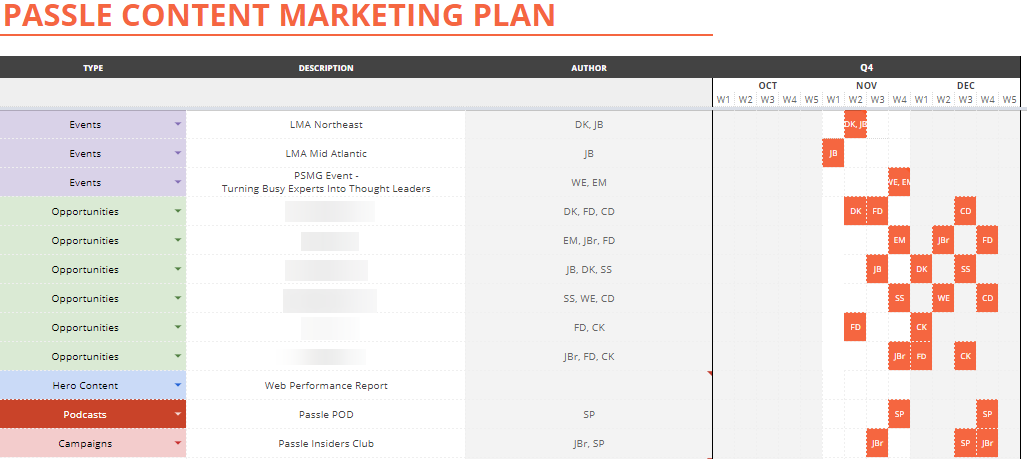It's that time of year when most marketers are trying to wrap up their budgets, their main core initiatives for 2020 and trying to formulate a strategy for growth in the new year.
There is an awesome video here from our friends from Applied Influence Group (and our friends at Crafty Counsel) that touches on a 7 question framework the British Army use in their planning.
These aren’t just academic questions. They apply to real situations and operations all the time.
It’s a useful framework to apply to your 2020 planning. I’ve written out the questions below with some comments on how I’ll be applying them to the Passle marketing efforts in 2020.

1. What is the other side doing and why?
Simply - what is happening in the market? What are our competitors doing and how are client expectations changing.
We’ve seen from our research that clients expect to access more and more information on firms and their people online so in 2020 we’ll be giving clients the chance to sign up directly to the insights that they want and making sure that the people in our firm are building their presence online.
2019 saw the rise of the business podcast and the cementing of video content as central to the marketing mix. 2020 will see more of that kind of content from us.
There are some great tips here from James Barclay on starting a podcast. My own advice for equipment and format is here as well.
In this category, we also look at shifts in the different channels being used. This includes things like Google updates and changes in behavior on social media networks.
2. What have I been told to do and why?
I read this as: How should my goals line up with the business? What are the core pillars of the overarching firm strategy and how can I support these?
Answering this question means understanding what your goals and objectives are as part of the wider business.
Aligning with the rest of the business is so essential to marketing & business development. I see marketing as a leader, out in front of the business building awareness and preparing clients and prospects for business development. If business development and the rest of the firm are not working towards the same purpose the marketing efforts will go to waste.
There is a short but fantastic podcast with Connor Kinnear here that discusses how to align sales & marketing.

3. What actions/effects do I want to have?
This part for me is about defining what you want to achieve this year with your marketing efforts. Once you’ve surveyed the landscape around you and understood the wider firm’s goals, you’ll need to translate that understanding into marketing goals.
Being specific, measurable, achievable, relevant and time based is essential for your goals. But I’d also suggest keeping the list of goals to a minimum whilst ensuring they are understandable and relevant for the whole business rather than just the marketing function.
The best marketing goals focus on the clients and prospects that matter.
4. Where can I best accomplish each action/effect?
What channels, activities and initiatives are going to be most effective in reaching our goals?
Inherently, marketing and business are risky. You need to make difficult choices around what to do and importantly, what not to do. Research, data analysis, and advice can help point you in the right direction but ultimately you need to make a decision, get the necessary buy-in and communicate that to your business.
My advice for this is threefold.
- Have a clear vision of the role of marketing, is it a tool for booking opportunity meetings or is it a way of reaching the people that count.
- Play to your strengths. In professional services, your greatest strength is the knowledge of your professionals.
- Be careful about which metrics you use to make your decisions. Some metrics may seem important but aren’t critical for driving growth.
5. What resources do I need to accomplish each action/effect?
This is a relatively straightforward question to translate into a marketing sense. It’s very very difficult to answer in practice. Budgeting is a balance (excuse the pun) between allocating enough time and money to each activity to get the job done effectively whilst at the same time trying not to overcommit to any given activity.
The best advice I’ve ever gotten on this came from our Client Success Director James Barclay when I started at Passle. He said:
“You’ll be asked to do everything. Nobody will be happy if you do loads of things to an average level. Pick a few things and do them really well”.
There is a great decision-making tool to use for this. It’s attributed to Eisenhower and helps to prioritise your activities.
Adam Elgar has a good post here about where high growth firms spend their marketing budget. This is backed up by a similar post on what B2B firms spent their budget on in relation to content.
6. When and where do these actions take place in relation to each other?
In any firm, no matter the size, it’s easy to be surprised by when and where different events on the marketing schedule would occur. Keeping everything on time and in sync with each other is one of the toughest parts of being a marketer.

I strongly suggest using a marketing calendar to track all this. You can include lead-in times and post-campaign activities. I wrote this post with Freddy Dobinson on this very topic. It looks at how to keep this calendar effective and useful, rather than being ignored or seen as just another task.
7. What control measures do I need to impose?
There are so many ways to interpret this question. One way that I like to see it is to say, what could go wrong with this plan and how can I prevent that or adjust in the event that something doesn’t go to plan?
One of the more effective control measures is an editorial policy this runs across the firm and informs how the brand and the people working for your firm communicate on behalf of the company.
It’s also worth noting here that problems arise not just digitally but in person. There are no brand guardians in sales meetings, so make sure that the right message is available for your people in those critical situations.
However, your plan for 2020 comes together, my key advice for starting the year would be as follows.
- Listen to your customers and act on the information you gather
- Understand and leverage the core strengths of your firm
- Be valuable to customers by incorporating expertise in your marketing










/Passle/53d0c8edb00e7e0540c9b34b/MediaLibrary/Images/2025-06-24-15-50-59-531-685ac963d81bf11b7522dd8e.png)
/Passle/53d0c8edb00e7e0540c9b34b/MediaLibrary/Images/2026-01-06-16-39-53-515-695d3ad9bb353efc045c6840.jpg)
/Passle/53d0c8edb00e7e0540c9b34b/MediaLibrary/Images/2025-12-31-15-17-59-924-69553ea7680d38d52ee4181c.jpg)
/Passle/53d0c8edb00e7e0540c9b34b/MediaLibrary/Images/2025-12-18-10-52-26-493-6943dceac311190ddba15d64.jpg)
/Passle/53d0c8edb00e7e0540c9b34b/MediaLibrary/Images/2025-12-16-15-16-25-843-694177c9190f803408651724.jpg)



